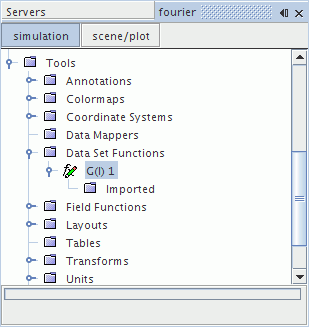Line Time Fourier Transforms
Line Time Fourier Transforms let you calculate Fourier transforms at various point along a line probe.
They allow the creation of either auto-spectra (see Eqn. (499)) or cross-spectra (Eqn. (500)) along the line probe.

Line Time Fourier Transform Properties
|
Start Signal |
The start time for the sampling of this object. |
|||
|
End Signal |
The end time for the sampling for this object. Clicking the
|
|||
|
Amplitude Function |
Specifies the amplitude function that is generated. These functions are all standard for this type of analysis.
|
|||
|
Power Spectral Density |
Frequency-domain description of the signal power. |
|||
|
Cross Spectral Density |
The power spectral density of the cross-spectrum signal. This option is comparable to the auto-spectral density of 1-point Fourier transforms. |
|||
|
Analysis Blocks |
Specifies the number of analysis blocks (see Eqn. (523)) for this data set function to use. |
|||
|
Overlap Factor |
Sets the overlap factor (see Eqn. (523)) between blocks, if any, in a range from 0 to 0.9. This property allows for smooth transitions between blocks. |
|||
|
Window Function |
Specifies the window function applied to the FT. The window function makes the signal periodic: it is guaranteed to be zero at both start and end. For most cases, apply a window function to a signal before applying an FT for best results. Available options:
|
|||
 property customizer button activates a property customizer that lets you specify both the time value and the appropriate time units (
property customizer button activates a property customizer that lets you specify both the time value and the appropriate time units (